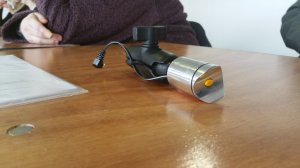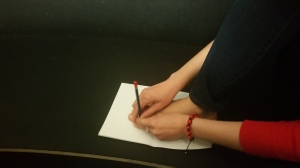In an era when cycling has become one of the main ways of getting around, and for many, a way of getting around the city cheaper, it is clear that the cycling boom is here to stay. The increase in the last decade, with some statistics claiming it to be as high as 60%, has seen bicycles make up 25% of the vehicles in the morning commute. That’s an outstanding figure!
Bike-Ability: The Cycle Revolution, was held Saturday 9th of April, and was a multisensory tour in response to the current Cycle Revolution exhibition at Design Museum, London. The exhibition runs from 18 November 2015 to 30 June 2016, celebrating the diversity of contemporary cycling in Britain from every day commuting to Olympic level competition, and looking at where design and innovation may take the riders of the future.
The Studio Session:

Image: A participant exploring a Cycle Wheel and it’s Spokes.
The tour started in the 1.5 studio with a discussion around current accessibility issues and some of the implementation of reasonable adjustment by institutions and other work places. Our focus on this tour was to explore materials and function, and how these materials used in the design of bicycles affects their function and usability. The history of bike-making itself reveals a host of materials, from steel, which is very tough but very heavy, to aluminium which is a lot lighter and will not rust, unlike steel, to the carbon fibre bikes which are almost 4 times stronger than steel but a lot more expensive, to the bamboo bikes, which have been quoted as been stronger by weight than steel.
So my question, to get us started, was to ask what memories we have of our first bicycles as kids, and what that experience was like?

Image: A participant handling the Bicycle A-frame.
We compared steel, aluminium and carbon fibre frames and quite evidently, it was clear that the aluminium frame was a lot lighter than the steel frame and it also does not rust like the steel frame will, but the carbon fibre frame was much lighter than the aluminium frame but also a lot more expensive.
Almost 4 times stronger than steel, the lightweight carbon fibre frame can be woven into shapes that metals cannot be made into, and where metals need welding at corners and joints, carbon fibres can be woven in one complete shape. Its durability makes it the choice of Olympic and all tour de France cyclists.

Image: A participant holding the loopwheel close to her and running her hands around the wheel.
The Loopwheel is a bicycle wheel that looks very much like a wheelchair or pushchair wheel and it uses an alternative to spokes to provide a more comfortable ride. The loopwheel springs which are the blue parts of the wheel positioned to replace bicycle spokes are constructed from carbon composite strips developed in conjunction with an archery bow manufacturer. These provide massive shock absorption so that what would have been a bumpy rides becomes a perfectly smooth ride. They are a lot more expensive than the regular wheels but do not need the maintenance that spokes may need.

Image: Participants holding the UltraBike as Julie from UltraCane explains how the technology works.
The UltraBike is an ultrasound kit designed to allow blind or visually impaired riders to cycle independently. The kit fixes onto the centre of the handlebars on any bicycle and is completely detachable.
The kit contains two ultrasound sensors that are positioned on the front, and these sensors point directly forward but also angled slightly outwards by 5 degrees. This ensures that the sensors can detect not just what is in front of the cyclist but also what is on either side of them.

Image: The tactor button on the arm of the UltraBike kit vibrates when the sensors detect an obstacle.
The tactor button is like an antenna that is used by touching, and the word tactor itself comes from the latin word tangier, which means to touch. The tactor buttons will vibrate when the sensors detect the boundary of the cycle track that is ridden around, giving ample warning so the cyclist is able to steer away from obstacles and stay on course.
Future Bike: Live Challenge:
The future bike live challenge explored the future of bicycle building and the Bamboo Bicycle Club with the Autumn Yard Design Collective were at hand to show our participants some of the processes involved in making a bamboo bike. This session was not just about building a bamboo bike because the challenge pushed the limits of their bamboo bike frames with the unique addition of 3D printed, carbon fibre reinforced lugs.

Image: A participant holds 2 bamboo frames together, smiling as she feels the texture and strength of the bamboo.
Bamboo is said to be stronger by weight than steel, which means 5 kilograms of bamboo gives you more strength and tensility than 5 kilograms of steel. That is why we hear of bamboo bridges and multi-story scaffolding in places like Vietnam.
Building performance bamboo bicycles is an intensive and lengthy process but when done properly, the rewards can be great, producing bicycle frames that are both stiff and durable, nimble and confident, and lively and smooth.

Image: A bamboo bike displayed at the entrance of the Design Museum.
Bamboo Bicycle Club conceived the idea to combine high-tech, open-source 3D printed components, with low tech, naturally sourced bamboo tubes. Teaming up with Oxford Brookes who specialise in the testing and analysis of 3D printed technology, vital expertise has gone into the realisation of this project.
Using 3D printed, carbon fibre reinforced lugs and bamboo frames, the goal is to prototype an open source bike that can be easily replicated by anyone.
The UltraBike Demonstration:

Image: The UltraBike kit mounted on a bicycle and ready to use.
We had a demonstration of the UltraBike with our participants and got to understand how the technology works in real life situation. The sensors detect at a range of 8 metres though this setting can be changed to suit the specific requirements of a cycle track.
On this occasion and as we were at the museum’s premises, we did not have a cycle track to test the full range and capability of the UltraBike but we did give all participants the opportunity to test how the kit feels to the touch, how easy the controls were to use, and how the various range settings allow the cyclist to detect things well ahead of themselves. This is a biomimicry of how bats and dolphins use sonar feedback and echolocation to find their way around.

Image: A participant about to have a short trial run on the UltraBike.
By giving the rider the ability to detect obstacles well ahead of themselves, the UltraBike range detection will allow the cyclist time to turn into a bend without cycling too acutely into or off the side of the track. The nearer you get to an obstacle or the boundary of the track, the higher the level of vibration. An understanding of the intricate feedback from the sensors helps the rider define the layout of the space around and this is what gives the rider the manoeuvre-ability to ride around a supervised cycle track, and in cycling clubs.
Cycle Revolution exhibition runs from 18 November 2015 to 30 June 2016.
Credits:
Handling objects property of the Design Museum
UltraBike kit, by UltraCane
Bamboo Bike, by Bamboo Bicycle Club
Note:
The Design Museum will be closing its current site on 30 June 2016, and will relocate to the former Commonwealth Institute building in Kensington, to open on 24 November 2016.
MaMoMi. All rights reserved 2016
























